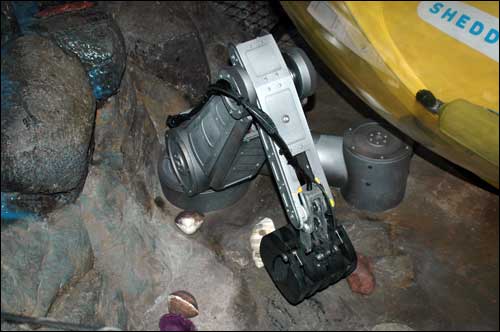When Chicago’s Shedd Aquarium began planning its interactive children’s section, known as the Oceanarium, project members didn’t want to install a large amount of technology. They felt the targeted age group—children between ages two and seven—did not need to press buttons or utilize robotics, because such technology tends to break when used by that age group. But the project team did want a system that would help kids understand the ocean in an interesting and interactive way.
“We wanted the kind of technology that would be easy to use,” says Tynetta Qaiyim, the aquarium’s project manager and director of exhibits programs, “but would require gross motor skills” (which are still developing in young children).

The project team members—many of whom had never heard of radio frequency identification—eventually came up with the idea for an exhibit that includes a submarine the children can enter in order to pretend they’re under the sea. There, they would use a joystick to remotely control an arm with a claw at the end of it, to pick up objects off a simulated ocean floor. If an object was picked up, a screen in the submarine would display information regarding that item. The question was how to identify the object so that the correct information could be displayed. The answer, the team found after some investigation, was RFID.
“We were sitting around the table, brainstorming, and we knew it was possible,” Qaiyim says. The project team spoke with several RFID vendors and purchased a TagSense 13.56 MHz RFID interrogator and SimpleTechnology tags, as well as Zinc 3.0 software to manage data from the reader.
The team embedded several tags in a number of objects, such as clams, other shells and rocks, which had been fabricated in-house out of plaster. They attached the reader to the front of the claw, and built a protective frame around it. Initially, Qaiyim says, the read rate was disappointing. More often than not, the claw reader did not interrogate the tags despite being centimeters away from a tagged object.
The staff purchased tags and a reader, embedded the tags in objects intended to simulate actual creatures and objects on the sea floor, and developed software that would display the information on whichever item a child picked up with the remote-controlled arm.
The aquarium hired media design firm Mightybytes, which provided media-related software and integration assistance. Mightybytes was already contributing video displays for the new Shedd exhibit, says Tim Frick, the design firm’s owner, and one of the company’s developers had worked on a similar RFID application.
Mightybytes resolved the low read-rate issue by increasing the number of tags in each object. Another option would have been to attach the tags to the outside of the items, but that would have been visible, he notes, and thus distracting. “They wanted realism for the objects,” Frick says, “so they had to cast the RFID tags inside.”
Mightybytes’ engineers pointed out a need for more tags, to ensure the interrogator could read tags through the material of the object the claw picked up, no matter what position that item was in. As a result, Frick says, they now have as many as 20 tags inside each of the five- or six-inch-long objects.
When the claw picks up an object, it reads the tag’s unique ID number (the tags on a particular item have ID numbers in a numeric series, all linked to that specific object in the software). The captured ID number is sent by the interrogator via a USB cable running the length of the arm, to a PC where the software resides. The software instructs the display of animated data specific to that object, on the screen within the submarine display. Media information is managed with Adobe‘s Flash and After Effects software, as well as Autodesk‘s 3D Studio MAX.
Mightybytes had approximately one week to get the system operating, Frick indicates. The system has been working since that time, Qaiyim reports, though the remote-control arm has had some mechanical problems. According to the Oceanarium, children seem to enjoy the interactivity of its simulated ocean environment. Some might grow up to be marine biologists—or RF engineers.


